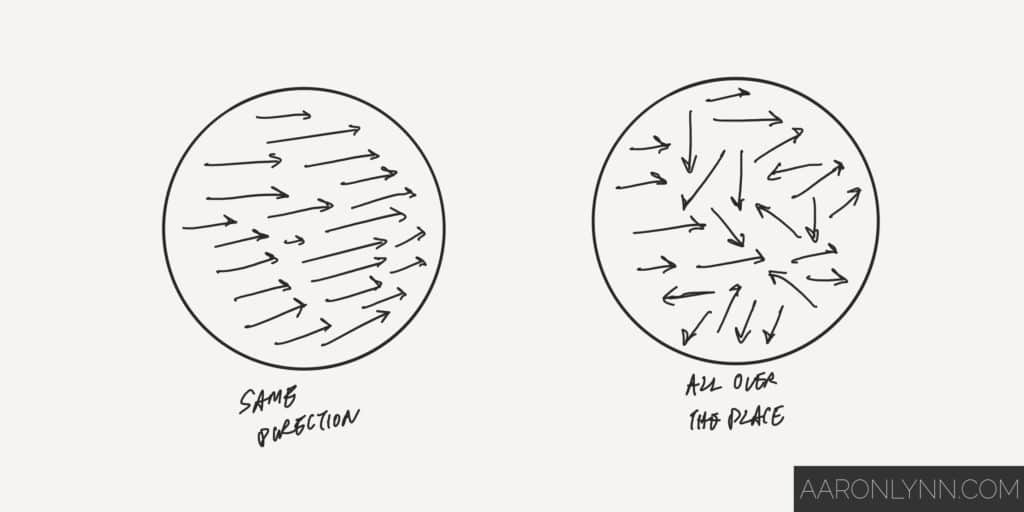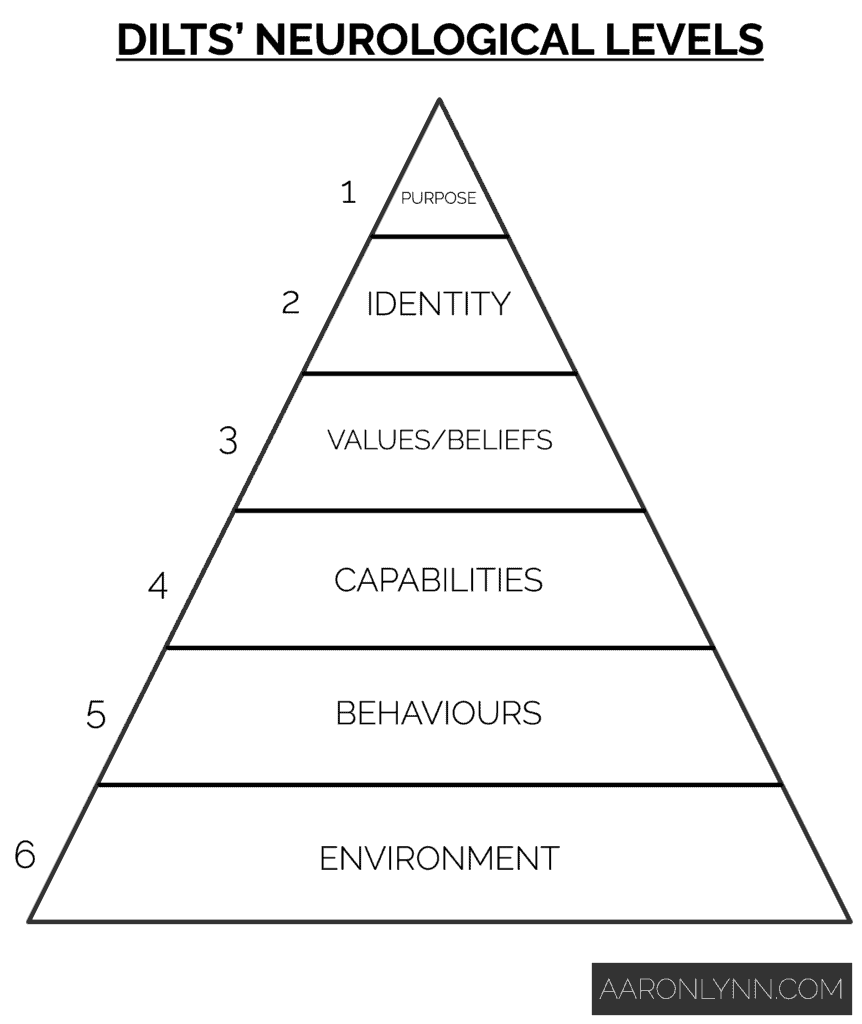
Your inner game is your mindset.
The term comes from performance coach Timothy Gallwey. He describes it as:
“How you non-judgementally observe the critical variables in your “game of life” and adjust and correct those to achieve the best possible performance.”
This is great in theory, but even better if we have a model that we can use to improve our inner game.
I am going to introduce you to a model called Dilts’ Neurological Levels1Created by NLP developer Robert Dilts. and show you how you can use it to improve your inner game and mindset.
Why Improve Your Inner Game and Mindset?
Everything you do in your life has two components:
- Outer game. The physical actions you take.
- Inner game. Your mindset in taking those actions.
To really excel, you need to work on both.
It isn’t enough to just learn the physical motions required to do something. You also need to improve the beliefs, heuristics and mental models behind it.
It is also the case that once a certain level of physical skill has been reached (for example, in high-level sports), further improvements can only be made by improving the inner game of the skill.
The way this works is that you improve the critical variables that make up your mental representation of a skill or activity, and then let these sink down to a subconscious level.
When you next perform that skill or ability, these improvements will show through.2i.e., you make better decisions in the moment.
Inner Game Model – Dilts’ Neurological Levels
The model I have found to be most useful for breaking apart the inner game of any activity is Dilts’ Neurological Levels.
It was created by NLP developer Robert Dilts a long, long time ago, and you can read more about the original model here.
This is my interpretation.
Level 1: Purpose
Your purpose is the answer to the question: why was I put here on this planet?
Part of the answer is long-term happiness, but you also need to ask – what else?
I’ll give you my purpose as an example – to create better systems so that we can live better lives.
Improving Purpose
Purpose is not so much “improved” as it is defined.
You simply need to think about and write down clearly what your purpose in life is.
There are a number of purpose discovery exercises out there on the interwebs, and all of them work. They all come back to the basic question of:
If you come one step back from saving or changing the world, what is it you really want to do?
Here’s my full guide on how to discover your purpose.
Level 2: Identity
Your identity answers the question: who are you?
This is not just what you do for a living, but who you are as a person – your character, and how you see and identify yourself.
Like this:

Each arrow represents an aspect of your identity, and the direction it is pulling you in.
Your identity is the sum of all these arrows and how aligned they are.
Improving Identity
It is difficult to work on your identity directly because it is more of an aggregate of everything else. A good start however, would be by defining your own personal ops documents.
It is also more accurate to say that your identity is changed rather than improved.
In order to change your identity, you need to work at the lower levels of values, beliefs, capabilities, behaviours and actions, and over time these will add up to a new identity.
Level 3: Values and Beliefs
Values
Values are the high-level principles that guide your split-second decision making and life.
Some people say that there is no right or wrong when it comes to your values.
I disagree.
Some values are conducive to high performance, while others are not.
Your values sit under your purpose and identity in the model and for this reason, selecting values is highly dependent on what you want for your life.
Here is my full guide to discovering, changing and weaponising your core values.
Beliefs
Beliefs exist at the same level as values, but instead of having maybe four-to-six values, you have hundreds if not thousands of beliefs.
They are the internal rules that govern what you can and cannot do, and how you perceive reality.
You can have both good beliefs and bad beliefs.3Also commonly referred to as positive and negative beliefs.
Some simple examples would be:
- It’s rude to put your feet on the table.
- You should love your parents unconditionally.
- If you work smart, you don’t have to work hard.
- We are made to produce, not consume.
- Motivation should be internal.
Improving Values and Beliefs
Values and Beliefs is the level at which we can start to improve things directly.
Depending on what you want to do in life, there are values and beliefs that are supportive of that… and there are values and beliefs that are not.
It is your job to work out which values and beliefs are supportive of your desired goals and purpose.
There are a number of belief change tools available but the easiest would be some form of conscious repetitive thought,4Like affirmations. backed by action.
You can also use belief change tools from NLP and Cognitive-Behavioural Therapy.
Level 4: Capabilities
Capabilities are our large-scale skills and what we are able to do.
There is a physical component to our capabilities, but there is also a mental component.
In the context of inner game, capabilities are important as we can often “map the path” of a physical skill by visualising it in our minds ahead of time.
In fact, this is exactly what professional athletes do to work on their inner game.5Clark, L. V. (1960). Effect of mental practice on the development of a certain motor skill. Research Quarterly of the American Association for Health, Physical Education, & Recreation, 31, 560–569.6Eckert, L. A. (1989). The Effects of Mental Imagery on Free Throw Performance. (Kinesiology, Sport Studies, and Physical Education Master’s Theses). The College at Brockport, State University of New York, USA. Retrieved from https://digitalcommons.brockport.edu/pes_theses/3/.7Whetstone, T. S. (1995). Enhancing Psychomotor Skill Development through the Use of Mental Practice. Journal of Industrial Teacher Education, 32(4), 5-31.
Examples of capabilities include:
- Complex skillsets like coding.
- Sports of any kind.
- Business domains of any kind.
Level 5: Behaviours
Behaviours are similar to capabilities and you can think of them as singular skills.
Lots of behaviours added up = a capability.
Examples of behaviours include:
- How we greet people.
- Our ability to swiftly dice vegetables on a cutting board.
- How we make small talk.
- Performing jump shots.
- Habits.
Improving Capabilities and Behaviours
Capabilities are large skillsets and behaviours are individual skills.
You improve both by studying and practicing.
The best way to improve your capabilities is with directed learning. This usually means taking a course and then practicing small behaviours over time.
The inner game component of this is to accelerate your learning by using visualisation as an aid.
There is no right or wrong with visualisation so long as you are doing it regularly.
Level 6: Environment
The bottom level of the model is the environment.
This is largely external, and the least important when it comes to your inner game.
It simply describes where your physical body is at any given time and the influence it may have on your mindset.
Improving Environment
“Improving your environment” is actually more effective the other way around.
You can set up your physical environments (like your home or workplace) to be conducive to the new mindsets you would like to adopt.
For example, removing all junk food from the house can assist in sticking with a new diet and health and fitness goals.
What To Do Next
The great thing about having a model for your inner game is that it’s no longer just nebulous “stuff in your head”.
You now know enough to map out and improve the inner game for anything that you do, or even just for performing in life.
You can read about more inner game models and techniques here.
- Created by NLP developer Robert Dilts.
- i.e., you make better decisions in the moment.
- Also commonly referred to as positive and negative beliefs.
- Like affirmations.
- Clark, L. V. (1960). Effect of mental practice on the development of a certain motor skill. Research Quarterly of the American Association for Health, Physical Education, & Recreation, 31, 560–569.
- Eckert, L. A. (1989). The Effects of Mental Imagery on Free Throw Performance. (Kinesiology, Sport Studies, and Physical Education Master’s Theses). The College at Brockport, State University of New York, USA. Retrieved from https://digitalcommons.brockport.edu/pes_theses/3/.
- Whetstone, T. S. (1995). Enhancing Psychomotor Skill Development through the Use of Mental Practice. Journal of Industrial Teacher Education, 32(4), 5-31.
Photo by James Pond.
